Did you know that not all RV water filters are created equal? We recently upgraded our RV Water filter system and here’s what we learned in the process.
Do you filter the fresh water coming into your RV? I hope you do. But, did you know that not all RV water filters are created equal?
If you walk around any RV park you’ll likely see a lot of the blue (or white) tube looking water filters. Chances are that’s what you have attached to your rig (if you have anything at all). Every once in a while you’ll see something a little different. Something bigger. You’ll wonder what that’s all about? What do those big canister filters do and is it really worth lugging something that large around? Does it really make a difference which water filter you use? Do you even need a water filter at all?

One of the first day items we bought was a basic blue water filter for our RV fresh water. To be honest, all we knew was that water sources vary and some kind of filter is necessary to reduce the amount of crud running through your pipes (and potentially into your body). Even with the blue filter, we still filtered our drinking water via a Brita filter pitcher (sometimes we even doubled up and used two Brita filters), because we just didn’t like the taste of what was coming through the faucet. This was our process for the first year in our rig.
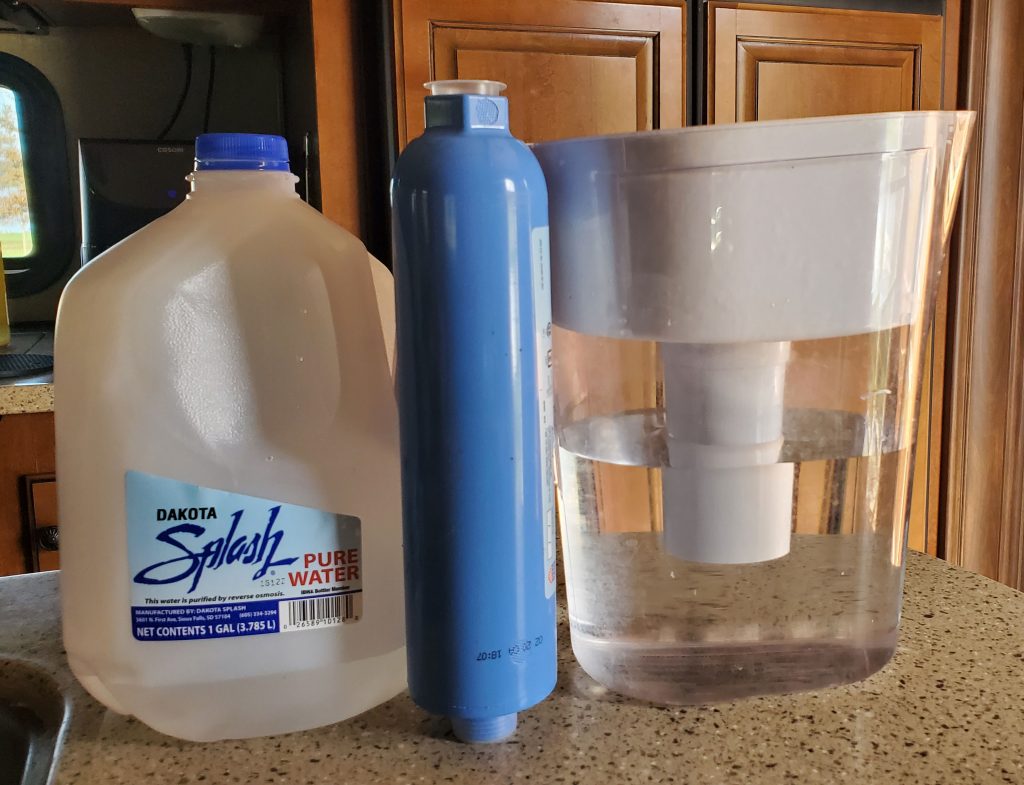
It wasn’t until a few months after we hit the road that we realized just how important a good water filtration system really is. Along our travels we definitely noticed differences in the water. Some parks had really hard water and others had really soft water. There were parks where even using two Brita filters wasn’t enough to make the water taste right. Even after changing out all of our filters the water still didn’t taste good. But, taste is only part of the issue.
Somewhere around the panhandle of Texas we started having stomach issues. Suddenly heartburn was keeping me awake at night, and causing nausea during the day. Foods that normally didn’t bother me caused major issues. At first I thought it was a bug I’d picked up somewhere, but after a week or so I knew it was something more. Especially when Brandon said he’d also been having more digestive issues than normal.
When we were still struggling weeks later, and getting worse instead of better (despite all the OTC options we tried), we made the decision to head back to Alabama and see our doctors. I was already scheduled for a full GI work-up this year, so it was just a matter of moving the schedule up a bit. We were sure we’d picked up something, but all of our tests came back clear. We still have no idea what caused our GI issues (and we’re still not completely over them).
Enter RV Water Filter Store
As fate would have it. Right about the time we began to question the quality of our water filtration system and started looking into better options, we were contacted by the RV Water Filter Store about trying out one of their systems.
We’d already been talking about the need to upgrade our filtration game and had started researching what systems would alleviate the risk of bacteria and viruses in the water, as well as filter out harmful levels of minerals and chemicals.
When I told them what we’d been dealing with and asked if they had systems that would help, the offered us their South of the Border system at a greatly reduced price.
The South of the Border system from RVWaterFilter Store is their “top of the line” system, which is their best point of entry system short of a custom Reverse Osmosis system.
This 3-stage filtration system from RV Water Filter Store does it all.
For comparison sake, the blue filter we’d been using was a 20 micron sediment filter – meaning that it filtered anything over 20 microns. Anything smaller than that would pass through the filter and into our fresh water supply. Brita filters are not micron filters, rather they just soften the water (absorbing the hard ions and replacing them with softer ones, making the water taste better, but doing little to actually make it safer).
The South of the Border 3-stage system
Stage 1 is a 1 micron reusable sediment filter.
Stage 2 is the RIO 2000 0.5 micron absolute ceramic filter. This filter removes bacteria, cysts, and sub micron particles from the water.
Stage 3 is a KDF/GAC BB activated-carbon filter that removes taste and odor issues, volatile organic compounds (VOCs), chlorine, lead, and heavy metals.

Absolute vs Nominal Microns
What’s a micron anyway? I micron is 1 thousandth of a millimeter. The smaller the micron rating, the smaller the size of the particles that get filtered out. Anything smaller than about 35 microns is too small to see without a microscope. For the best filtration you want to make sure that your filtration system removes particles smaller than 1 micron absolute.
Absolute micron filters measure at the exact size they state. An absolute micron filter removes at least 95% of particles larger than the specified micron size. However, nominal filters allow 20-30% of the larger particles to pass through.
The RV Water Filter store systems remove much smaller particles than a standard filter. We’re all a little jaded these days, though, so it’s one thing to say a product does something. It’s another thing to see it in action.
Test 1: the TDS (totally dissolved solids) test. We’ve had this little TDS tester on hand ever since I bought a Zero water filter pitcher a few years back. The Zero water filter pitchers make this big claim that they remove 99.6% of TDSs from your water and even send a tester with your pitcher so you can see it in action. This misled me to believe that TDSs were the harmful substances that needed to be removed.
We used this tester and generally found that the blue filter got the TDS level down to about 100ppm. Double filtering it through two Brita pitchers would usually get us down to about 30ppm.
After we hooked up the South of the Border system from RV Water Filter store, I tested the water with our TDS tester. Huh, the ppm were almost exactly the same as through our blue filter. That didn’t seem right.
So, I did some digging and here’s what I learned. TDSs are not necessarily a measure of anything dangerous in your water. TDS is a measure of dissolved contaminants in your water that are small enough to pass through a 2 micron filter. As far as the EPA is concerned these aren’t really a threat – just a nuisance, and in some cases not even that.
Totally dissolved solids come from many sources including minerals absorbed through the ground, contaminants from agriculture and industry, organic and inorganic contaminants from water runoff, wastewater discharges, septic systems and by-products of oil and gas production, mining or farming. TDS’s can also include disinfectants and disinfection byproducts, radioactive contaminants, and microbial contaminants.
The maximum PPM allowed by the EPA is 500ppm. TDS levels over 1000ppm are considered unsafe for human consumption. We’ve seen this in too many places even here in the US. Average drinking water has anywhere between 100-300ppm.
Water that is higher in TDS is likely to not taste as good. It will taste more bitter, metallic, or salty, and possibly even have a bad smell. Too much water high in TDS over time can wear on the body, and it can also lead to faster corrosion of your water heater.
“TDS gives you an idea how much “stuff” is dissolved in the water, but doesn’t tell you what it is, so you really can’t get a good read on the quality of the water with just TDS. It could be calcium and magnesium or iron, both of which have observable symptoms, or it could be beneficial minerals that are good for you and don’t have any taste or smell associated with them.”
David Brannam, owner RVWaterFilterStore
Tip: If you don’t already be sure to check your water heater anode rod at least once a year (more often if you are full-time). When we changed ours and flushed our water heater we were amazed at how much salt and mineral build up had occurred. This is what hard water does.
To completely remove TDS from your water you need a Reverse Osmosis system, deionizer, or a resin filter that removes specific minerals.
After researching I found that the level of TDS in our water was fine. Remember how the Brita replaces harder ions with softer ones? It’s basically replacing one type of TDS for another (usually calcium and magnesium ions are replaced with sodium ions). Those TDS test sticks only tell you the level of Totally Dissolved Solids, they don’t tell you what kind of TDS is in your water.
The Water Quality Test
To know what’s in your water you need a water quality test kit. RV Water Filter Store sells one, and there are many available on Amazon as well. I found one that came with two test kits so that we could test and compare the water that comes through the blue filter to the water that was filtered by the South of the Border system.
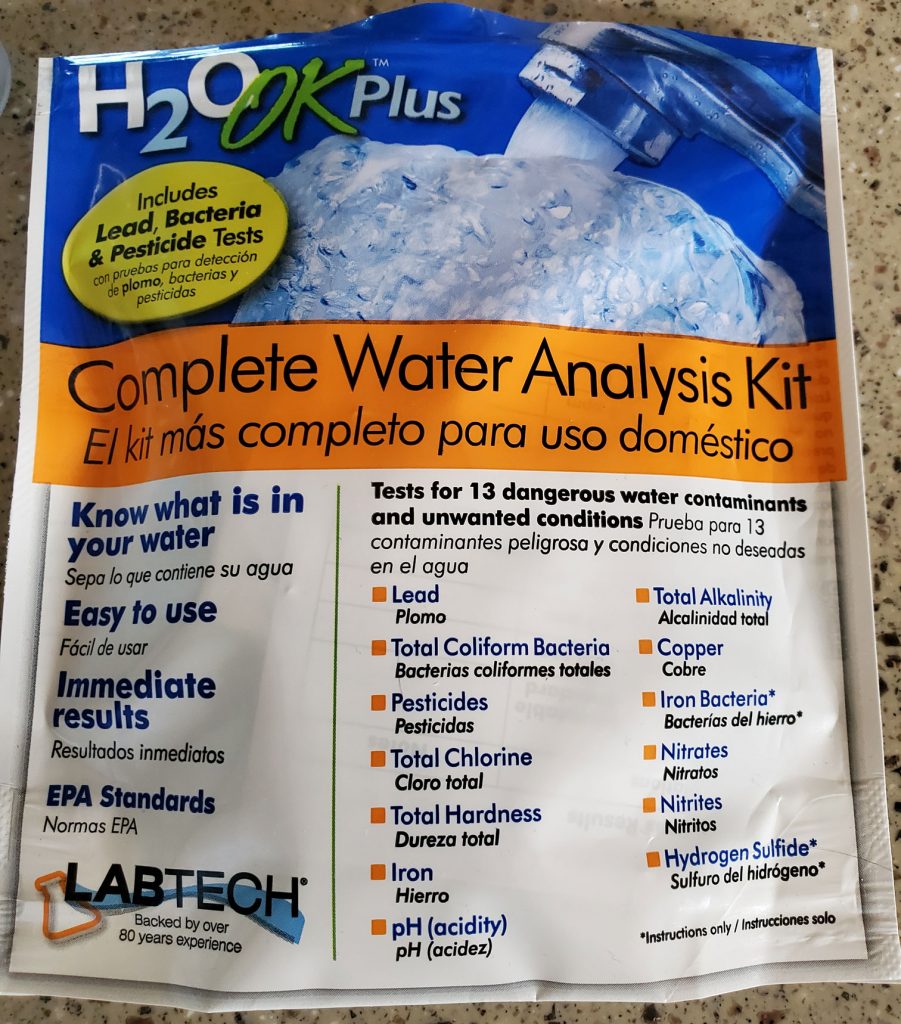
When we ran these tests we were at Lake Guntersville State Park, where we’ve spent a lot of time over the last year and haven’t had any issues with the water. We plan to run these tests again the next time we find ourselves off the beaten path.
Even though the water there is generally good we wanted to see the difference between what we get through the basic blue filter and what we get through our new RVWaterFilterStore South of the Border system.
I actually wish we’d been gotten an extra test so that we could compare the unfiltered water as well for a baseline. However, even without that we did find differences between the blue filter and the South of the Border system. The test we ran tested six factors – total hardness, total chlorine, alkalinity, pH, nitrites, and nitrates. The main differenced we saw on this test was that the blue filter showed very low pH levels.
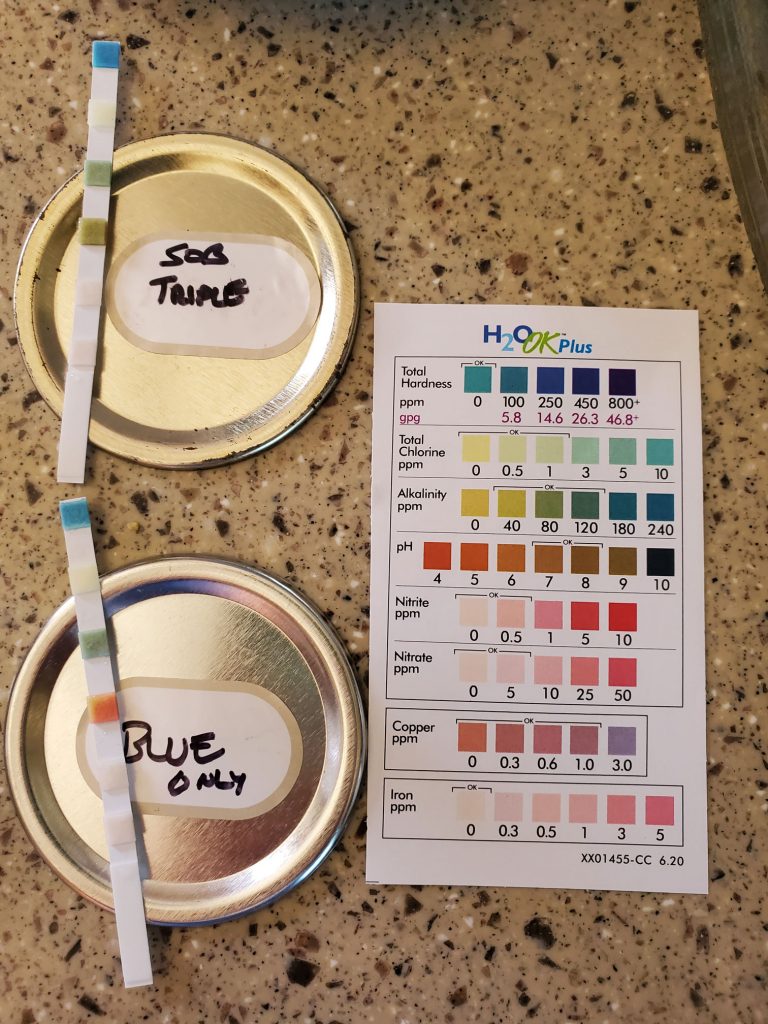
The Real Test – How does the water taste?
We can look at numbers and test results all day and they definitely matter when it comes to knowing the quality of your water and feeling confident that it’s safe to drink. But, even if the water is perfectly pure, it’s got to taste good. This is the real test and our water filtered through the 3-stage system from RV Water Filter store passed that test with flying colors. Our drinking water (for the first time in memory) tastes as good as quality bottled water.
Our water, also, now does a better job of quenching our thirst. For years, I’ve felt constantly thirsty. I carry around a 24oz bottle that stays filled. I still drink a lot of water, but I’m not going through it at nearly the same rate, nor feeling the same level of unquenched thirst. I’d say that’s a win.


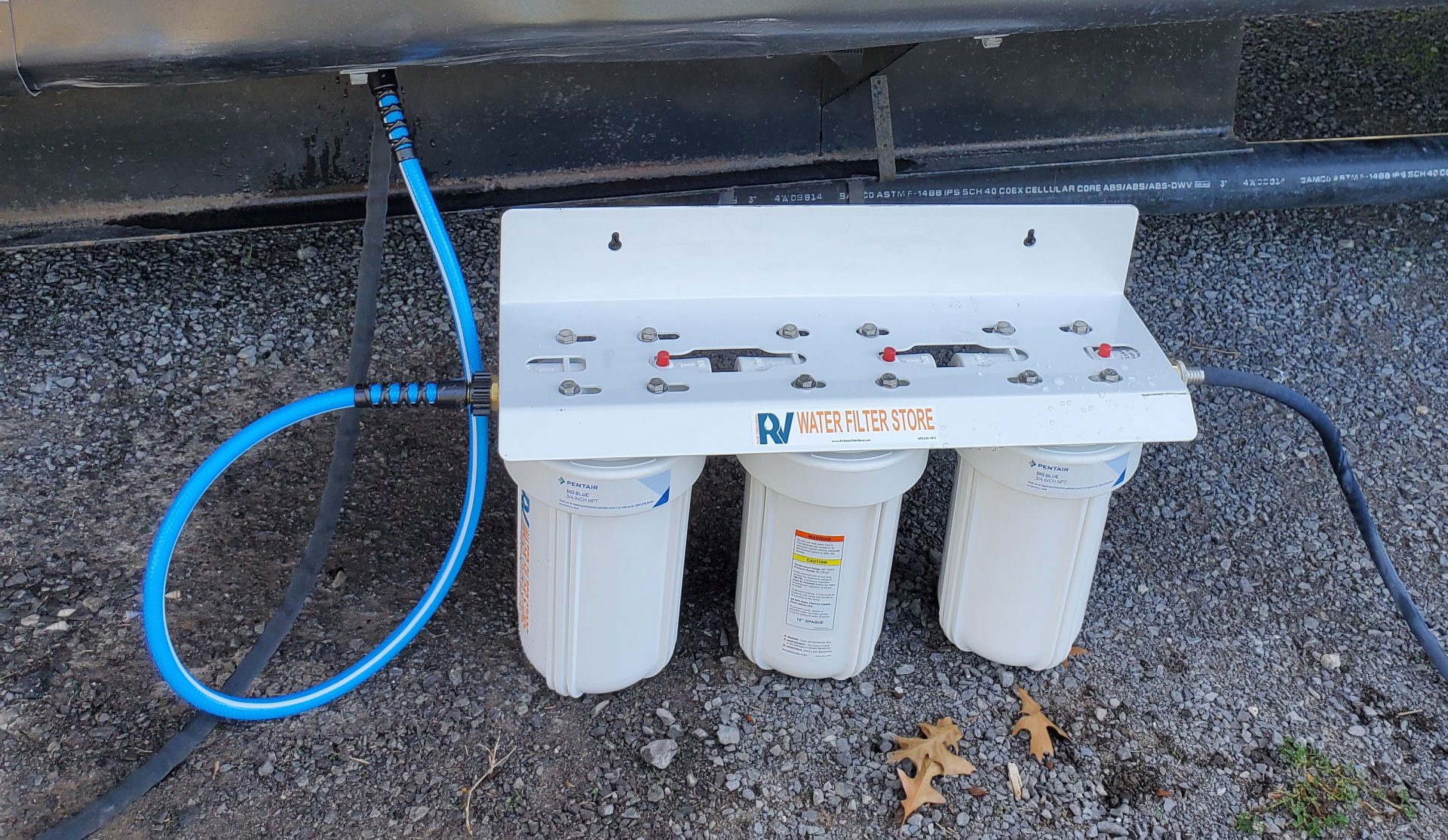
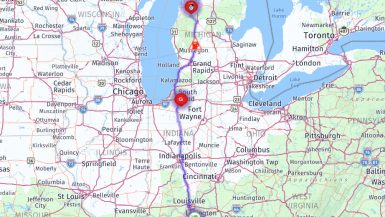
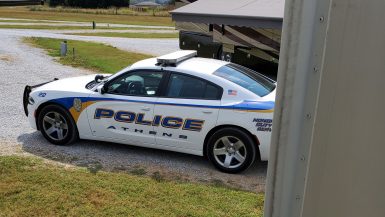
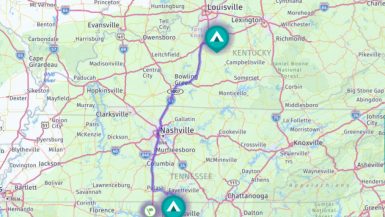
Leave a reply